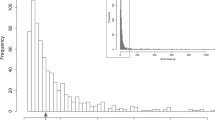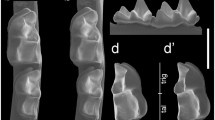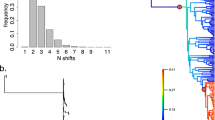Abstract
Traditionally, bats (Order Chiroptera) are divided into two suborders, Megachiroptera (“megabats”) and Microchiroptera, and this nomenclature suggests a consistent difference in body size. To test whether megabats are, in fact, significantly larger than other bats, we compared them with respect to average body mass (log transformed), using both conventional and phylogenetic statistics. Because bat phylogeny is controversial, including the position of megabats, we employed several analyses. First, we derived two generic-level topologies for 101 genera, one with megabats as the sister of all other bats (“morphological” tree), the other with megabats as the sister of one specific group of microbats, the Rhinolophoidea (“molecular” tree). Second, we used a recently published “supertree” that allowed us to analyze body mass data for 656 species. In addition, because the way body mass has evolved is generally unknown, we employed several sets of arbitrary branch lengths on both topologies, as well as transformations of the branches intended to mimic particular models of character evolution. Irrespective of the topology or branch lengths used, log body mass showed highly significant phylogenetic signal for both generic and species-level analyses (all P≤ 0.001). Conventional statistics indicated that megabats were indeed larger than other bats (P ≪ 0.001). Phylogenetic analyses supported this difference only when performed with certain branch lengths, thus demonstrating that careful consideration of the branch lengths used in a comparative analysis can enhance statistical power. A conventional Levene's test indicated that log body mass was more variable in megabats as compared with other bats (P=0.075 for generic-level data set, P ≪ 0.001 for species-level). A phylogenetic equivalent, which gauges the amount of morphospace occupied (or average minimum rate of evolution) relative to topology and branch lengths specified, indicated no significant difference for the generic analyses, but did indicate a difference for some of the species-level analyses. The ancestral bat is estimated to have been approximately 20–23 g in body mass (95% confidence interval approximately 9–51 g).
Similar content being viewed by others
LITERATURE CITED
Ackerly, D. D. (2000). Taxon sampling, correlated evolution, and independent contrasts. Evolution 54: 1480-1492.
Altringham, J. (1996). Bats: Biology and behavior. Oxford Univeristy Press, Oxford, UK.
Barclay, M. R., and Brigham, R. (1991). Prey detection, dietary niche breadth, and body size in bats: Why are aerial insectivorous bats so small? Am. Nat. 137: 693-703.
Bininda-Edmonds, O. R. P., Gittleman, J. L., and Steel, M. A. (2002). The (super)tree of life: Procedures, problems, and prospects. Ann. Rev. Ecol. Syst. 33: 265-289
Blomberg, S. P., and Garland, T., Jr. (2002). Tempo and mode in evolution: Phylogenetic inertia, adaptation and comparative methods. J. Evol. Biol. 15: 899-910.
Blomberg, S. P., Garland, T., Jr., and Ives, A. R. (2003). Testing for phylogenetic signal in comparative data: Behavioral traits are more labile. Evolution 57: 717-745.
Clobert, J., Garland, T., Jr., and Barbault, R. (1998). The evolution of demographic tactics in lizards: A test of some hypotheses concerning life history evolution. J. Evol. Biol. 11: 329-364.
D´ýaz-Uriarte, R., and Garland, T., Jr. (1996). Testing hypotheses of correlated evolution using phylogenetically independent contrasts: Sensitivity to deviations from Brownian motion. Syst. Biol. 45: 27-47.
D´ýaz-Uriarte, R., and Garland, T., Jr. (1998). Effects of branch length errors on the performance of phylogenetically independent contrasts. Syst. Biol. 47: 654-672.
Dobson, G. E. (1875). Conspectus of the suborders, families and genera of Chiroptera arranged according to their natural affinities. Ann. Mag. Nat. Hist. 16: 345-357.
Felsenstein, J. (1985). Phylogenies and the comparative method. Am. Nat. 125: 1-15.
Fenton, M. B., Audet, D., Obrist, M. K., and Rydell, J. (1995). Signal strength, timing, and self-deafening: The evolution of echolocation in bats. Paleobiology 21: 229-242.
Freckleton, R. P., Harvey, P. H., and Pagel, M. (2002). Phylogenetic analysis and comparative data: A test and review of evidence. Am. Nat. 160: 712-726.
Freeman, P. W. (1981). A multivariate study of the family Molossidae (Mammalia: Chiroptera): Morphology, ecology, and evolution. Fieldiana Zool. ns, no. 7.
Freeman, P. W. (2000). Macroevolution in Microchiroptera: Recoupling morphology and ecology with phylogeny. Evol. Ecol. Res. 2: 317-335.
Garland, T., Jr., Dickerman, A. W., Janis, C. M., and Jones, J. A. (1993). Phylogenetic analysis of covariance by computer simulation. Syst. Biol. 42: 265-292.
Garland, T., Jr., Harvey, P. H., and Ives, A. R. (1992). Procedures for the analysis of comparative data using phylogenetically independent contrasts. Syst. Biol. 41: 18-32.
Garland, T., Jr., and Ives, A. R. (2000). Using the past to predict the present: Confidence intervals for regression equations in phylogenetic comparative methods. Am. Nat. 155: 346-364.
Garland, T., Jr., Martin, K. L. M., and D´ýaz-Uriarte, R. (1997). Reconstructing ancestral trait values using squared-change parsimony: Plasma osmolarity at the origin of amniotes. In: Amniote Origins: Completing the Transition to Land, S. S. Sumida and K. L. M. Martin, eds., pp 425-501, Academic Press, San Diego.
Garland, T., Jr., Midford, P. E., and Ives, A. R. (1999). An introduction to phylogenetically based statistical methods, with a new method for conidence intervals on ancestral values. Am. Zool. 39: 374-388.
Gatesy, J., and Springer, M. S. (in press). A critique of matrix representation with parsimony supertrees. In: Phylogenetic Supertrees: Combining Information to Reveal the Tree of Life, O. R. P. Bininda-Edmonds, ed., Computational Biology Series, Kluwer Academic, Dordrecht, The Netherlands.
Gatesy, J., Matthee, C., DeSalle, R., and Hayashi, C. Y. (2002). Resolution of a supertree/supermatrix paradox. Syst. Biol. 51: 652-664.
Grafen, A. (1989). The phylogenetic regression. Phil. Trans. R. Soc. Lond. B 326: 119-156.
Griffiths, T. A. (1994). Phylogenetic systematics of the slit-faced bats (Chiroptera: Nycteridae) based on hyoid and other morphology. Am. Mus. Nov. 3090: 1-17.
Griffiths, T. A., Truckenbrod, A., and Spnholtz, P. J. (1992). Systematics of Megadermatid bats (Chiroptera: Megadermatidae) based on hyoid morphology. Am. Mus. Nov. 3041: 1-21.
Habersetzer, J., and Storch, G. (1989). Ecology and echolocation of Eocene Messel bats. In: European Bat Research, V. Hanak, I. Horacek, and J. Gaisler, eds., pp 213-233, Charles University Press, Prague.
Hand, S. J., and Kirsch, J. A. W. (1998). A southern origin for the Hipposideridae (Microchiroptera)? In: Bat Phylogeny, Morphology, Echolocation, T. H. Kunz and P. A. Racey, eds., Smithsonian Institution Press, Washington D.C.
Harmon, L. J., Schulte, J. A., II, Larson, A., and Losos, J. B. (2003). Tempo and mode of evolutionary radiation in iguanian lizards. Science 301: 961-964.
Harvey, P. H., and Pagel, M. D. (1991). The Comparative Method in Evolutionary Biology, Oxford University Press, Oxford.
Harvey, P. H., and Rambaut, A. (1998). Phylogenetic extinction rates and comparative methodology. Proc. R. Soc. Lond. B 265: 1691-1696.
Harvey, P. H., and Rambaut, A. (2000). Comparative analyses for adaptive radiations. Phil. Trans. R. Soc. Lond. B 355: 1599-1605.
Hill, J. D., and J. E. Smith. (1980). Bats a natural history. Univerisity of Texas Press, Austin.
Hutcheon, J. M., and Kirsch, J. A. W. (2004). Camping in a different tree: Results of molecular systematic studies of bats using DNA-DNA hybridization. J. Mamm. Evol. 11: 17-37.
Hutcheon, J. M., Kirsch, J. A. W., and Pettigrew, J. D. (1998). Base compositional biases and the bat problem. III. The question of microchiropteran monophyly. Phil. Trans. R. Soc. Lond. B 353: 607-617.
James, F. C. (1982). The ecological morphology of birds. Ann. Zool. Fennici 19: 265-275.
Jones, G. (1994). Scaling of windbeat and echlocation pulse emission rates in bats: why are aerial insectivorous bats so small? Funct. Ecol. 8: 450-457.
Jones, K. E., Purvis, A., MacLarnon, A., Bininda-Emonds, O. R. P., and Simmons, N. B. (2002). A phylogenetic supertree of the bats (Mammalia: Chiroptera). Biol. Rev. 77: 223-259.
Kalko, E. K. V., and Condon, M. A. (1999). Echolocation, olfaction and fruit display: how bats find fruit of flagellichorous cucurbits. Funct. Ecol. 12: 364-372.
Kirsch, J. A. W., Flannery, T. F., Springer, M. S., and Lapointe, F.-J. (1995). Phylogeny of the Pteropodidae (Mammalia: Chiroptera) based on DNA hybridization, with evidence for bat monophyly. Aust.J.Zool. 43: 395-428.
Kirsch, J. A. W., Hutcheon, J. M., Byrnes, D. G. P., and Lloyd, B. D. (1998). Affinities and historical zoogeography of the New Zealand short-tailed bat, Mystacina tuberculata Gray 1843, inferred from DNA-hybridization comparisons. J. Mamm. Evol. 5: 33-64.
Lapointe, F.-J., Kirsch, J. A. W., and Hutcheon, J. M. (1999). Total evidence, consensus, and bat phylogeny: A distance-based approach. Mol. Phylogenet. Evol. 11: 55-66.
Lavasseur, C., Landry, P.-A., Makarenkov, V., Kirsch, J. A. W., and Lapointe, F.-J. (2003). Incomplete distance matrices, supertrees, and bat phylogeny. Mol. Phylogenet. Evol. 27: 239-246.
Mack, A. L. (1993). The sizes of vertbrate-dispersed fruits: A neotropical-paleotropical comparison. Am. Nat. 142: 840-856.
Marshall, A. G. (1983). Bats, flowers and fruit: Evolutionary relationships in the Old World. Biol. J. Linn. Soc. 20: 115-135.
McClain, C. R., Johnson, N. A., and Rex, M. A. (2004). Morphological disparity as a biodiversity metric in lower bathyal and abyssal gastropod assemblages. Evolution 58: 338-348.
McNab, B. K. (2003). Standard energetics of phyllostomid bats: The inadequacies of phylogenetic-contrast analyses. Comp.Biochem.Physiol. A135: 357-368.
Norberg, U. M. (1990). Zoophysiology, Vol. 27, Springer-Verlag, Berlin.
Norberg, U. M. (1994). Wing design, flight performance, and habitat use in bats. In: Ecological Morphology: Integrative Organismal Biology, P. C. Wainwright and S. M. Reilly, eds., pp. 205-239, University of Chicago Press, Chicago.
Norberg, U. M., and Rayner, J. M. V. (1987). Ecological morphology and flight in bats (Mammalia: Chiroptera): Wing adaptations, flight performance, foraging strategy and echolocation. Phil. Trans. Roy. Soc. Lond. B 316: 335-427.
Pagel, M. D. (1992). A method for the analysis of comparative data. J. Theor. Biol. 156: 431-442.
Pettigrew, J. D. (1991a). Wings or brain? Convergent evolution in the origins of bats. Syst. Zool. 40: 199-216
Pettigrew, J. D. (1991b). A fruitful wrong hypothesis? Response to Baker, Novacek, and Simmons. Syst. Zool. 40: 231-239.
Pettigrew, J. D., Jamieson, B. G. M., Robson, S. K., Hall, L. S., McAnally, K. I., and Cooper, H. M. (1989). Phylogenetic relations between microbats, megabats and primates (Mammalia: Chiroptera and Primates). Phil. Trans. R. Soc. Lond. B 325: 489-559.
Pumo, D. E., Finamore, P. S., Franek, W. R., Phillips, C. J., Tarzami, S., and Balzarano, D. (1998). Complete Mitochondrial Genome of a Neotropical Fruit Bat, Artibeus jamaicensis, and a New Hypothesis of the Relationships of Bats to Other Eutherian Mammals. J. Mol. Evol. 47: 709-717.
Purvis, A. (1995). A composite estimate of primate phylogeny. Phil. Trans. R. Soc. Lond. B 348: 405-421.
Purvis, A., and Garland, T., Jr. (1993). Polytomies in comparative analyses of continuous characters. Syst. Biol. 42: 569-575.
Robbins, L. W., and Sarich, V. M. (1986). Evolutionary relationships in the family Emballonuridae (Chiroptera). J. Mamm. 69: 1-13.
Schluter, D., Price, T., Mooers, A. O., and Ludwig, D. (1997). Likelihood of ancestor states in adaptive radiation. Evolution 51: 1699-1711.
Silva, M., and Downing, J. (1995). The CRC Handbook of Mammalian Body Masses, CRC Press, Boca Raton, FL.
Simmons, N. B. (1994). The case for chiropteran monophyly. Am. Mus. Nov. 3103: 1-54.
Simmons, N. B., and Geisler, J. B. (1998). Phylogenetic relationships of Icaronycteris, Archaeonycteris, Has-sianycteris, andPalaeochiropteryx to extant bat lineages, with comments on the evolution of echolocation and foraging strategies in Microchiroptera. Bull. Am. Mus. Nat. Hist. 235: 1-182.
Smith, J. D. (1976). Chiropteran evolution. In: Biology of Bats of the New World Family Phyllostomidae. Part I, R. J. Baker, J. K. Jones Jr., and D. C. Carter, eds., pp. 49-69, Special Publication of the Museum, Texas Tech, Lubbock.
Smith, F. A., Lyons, S. K., Morgan Ernest, S. K., Jones, K. E., Kaufman, D. M., Dayan, T., Marquet, P. A., Brown, J. H., and Haskell, J. P. (2003). Body mass of Late Quaternary mammals. Ecology 84: 3403. (Ecological Archives E084-E094)
Speakman, J. R. (2001). The evolution of flight and echolocation in bats: Another leap in the dark. Mamm. Rev. 31: 111-130.
Springer, M. S., Hollar, L. J., and Kirsch, J. A. W. (1995). Phylogeny, molecules versus morphology, and rates of character evolution among fruitbats (Chiroptera: Megachiroptera). Aust. J. Zool. 43: 557-582.
Springer, M. S., Teeling, E. C., Madsen, O., Stanhope, M. J., and de Jong, W. W. (2001). Integrated fossil and molecular data reconstruct bat echolocation. Proc. Natl. Acad. Sci. U.S.A. 98: 6241-6246.
Teeling, E. C., Madsen, O., Murphy, W. J., Springer, M. S., and O'Brien, S. J. (2003). Nuclear gene sequences confirm an ancient link between New Zealand's short-tailed bat and South American noctilionoid bats. Mol. Phylogenet. Evol. 28: 308-319.
Teeling, E. C., Madsen, O., Van Den Bussche, R. A., de Jong, W. W., Stanhope, M. J., and Springer, M. S. (2002). Microbat paraphyly and the convergent evolution of a key innovation in Old World rhinolophoid microbats. Proc. Nat. Acad. Sci. U.S.A. 99: 1431-1436.
Teeling, E. C., Scally, M., Kao, D. J., Romagnoli, M. L., Springer, M. S., and Stanhope, M. J. (2000). Molecular evidence regarding the origin of echolocation and flight in bats. Nature 403: 188-192.
Thies, W., Kalko, E. K. V., and Schnitzler, H.-U. (1998). The roles of echolocation and olfaction in two Neotropical fruit-eating bats, Carollia perspicillata and C. castanea feeding on Piper. Behav. Ecol. Sociobiol. 42: 397-409.
Van Cakenberghe, V., Herrel, A., and Aguirre, L. F. (2002). Evolutionary relationships between cranial shape and diet in bats (Mammalia: Chiroptera). In: Topics in Functional and Ecological Vertebrate Morphology, P. Aerts, K. D'Août, A. Herrel, and R. Van Damme, eds., pp. 205-236, Shaker Publishing, Maastricht, The Netherlands.
Van Den Bussche, R. A., and Hoofer, S. R. (2004). Phylogenetic relationships among recent chiropteran families and the importance of choosing appropriate outgroup taxa. J. Mamm. 85: 321-220.
von Helverson, D., and von Helverson, O. (1999). Acoustic guide in bat pollinated flower. Nature 398: 759-760.
Vanhooydonck, B., and Van Damme, R. (1999). Evolutionary relationships between body shape and habitat use in lacertid lizards. Evol. Ecol. Res. 1: 785-805.
Weins, J. J. (2003) Missing data, incomplete taxa, and phylogenetic accuracy. Syst. Biol. 52: 528-538.
Wetterer, A. L., Rockman, M. V., and Simmons, N. B. (2000). Phylogeny of phyllostomid bats (Mammalia: Chiroptera): Data from diverse morphological systems, sex chromosomes, and restriction sites. Bull. Am. Mus. Nat. Hist. 248: 1-200.
Wilson, D. E., and Reeder, D. M. (eds.). (1993). Mammal Species of the World, Smithsonian Institute Press, Washington, DC.
Author information
Authors and Affiliations
Rights and permissions
About this article
Cite this article
Hutcheon, J.M., Garland, T. Are Megabats Big?. Journal of Mammalian Evolution 11, 257–277 (2004). https://doi.org/10.1023/B:JOMM.0000047340.25620.89
Issue Date:
DOI: https://doi.org/10.1023/B:JOMM.0000047340.25620.89




